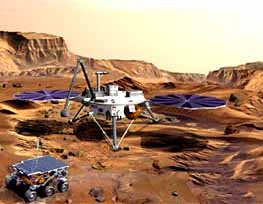| . |  |
. |
|
by Morris Jones  Sydney - January 12, 2000 - The failure of Mars Polar Lander could not have come at a worse time. NASA is plagued by funding difficulties and the tensions over the survival of individual programs that inevitably results from this.
Sydney - January 12, 2000 - The failure of Mars Polar Lander could not have come at a worse time. NASA is plagued by funding difficulties and the tensions over the survival of individual programs that inevitably results from this.The problems of the International Space Station are of Herculean proportions and Shuttle launches are sporadic events. NASA is clearly ailing, and the impact of any further problems is magnified. Although NASA's investigation into the loss of MPL has yet to report its conclusions, it's important to remember that we will never know for certain why the lander failed. In the absence of solid facts, all manner of theories will be advanced. Some of these will be reasonable guesses, but others will certainly be designed to push agendas. We will certainly need to draw lessons from the MPL mission, but it's important that the investigation is not used to allocate blame in an unfair fashion. Payloads leave Earth for space every week. The sky above us is filled with hundreds of satellites. It would seem that space travel is routine. Yet fewer than one percent of all the objects launched into space head for the interplanetary realm. Deep space exploration is still a relatively new art. It brings problems that are never encountered by engineers who park communications satellites in geostationary orbit slots. Landing on a planetary surface is even more difficult. One must negotiate atmospheres with properties that are not always properly understood, surviving extreme temperatures and abnormal pressures. Weather hazards that would prompt the return of Earth-orbiting spacecraft to be postponed cannot always be avoided. The surface of any planet is less welcoming than an airstrip. Even on terrain that looks smooth from orbit, boulders or other traps in the ground can lurk. Landing a spacecraft in an automatic fashion is essentially a gamble. One simply hopes that no hazards are present in the exact patch of ground where the spacecraft touches down. Previously, NASA has been extremely lucky in playing this game. Three landers have touched down successfully on Mars. But even these have hinted at the risks in landing on the planet. One Viking footpad landed on a small boulder, giving the lander a tilt. Another footpad sank down into soft soil, burying it from view. One both Pathfinder and Viking, large rocks that could have impeded a landing were visible within a short range of the landing site. These problems occurred in regions that were considered to be amongst the safest on Mars. The latest mission was targeted at a region that looked considerably more hazardous, even from orbit. Add the unique properties that the polar regions of Mars are believed to possess, and the hazards grow larger. We do not know for sure if some unforseen combination of dust or ice kicked up by the lander at touchdown has damaged the spacecraft, or even caused it to sink into pit of dust. Such a small, local anomaly would not be visible from orbit, or even to radar. As Viking showed, terrain can be extremely varied across the span of a lander itself! Viking and Pathfinder were both well-prepared missions from an engineering perspective, yet if their landings had been interrupted by surface features, their engineering would probably have been called into question. The sheer success of these missions has produced expectations that are difficult to fulfil in the long term. Eventually, a Mars lander had to fail. NASA must continue with its Mars Surveyor Program. Compared to the performance of human spaceflight, its track record is not as bad as it may seem. We should sit back, ask questions, but not attack without justification. Planetary exploration is really just beginning, and we have been lucky in general to have a high success rate. That can only be sustained through practice, which in turn means launching more missions. There is no easy road to the planets, just as there was no easy way to begin space exploration itself. Exploration has always required commitment and stoicism in the face of obstacles. Hopesfully, NASA and the general public will take this into account. Morris Jones is a Sydney, Australia-based consultant and journalist. He can be reached at morrisjonesNOSPAMhotmail.com. Replace NOSPAM with @ to send email.
Related Links
EARTH INVADES MARS
|
| |||||||||
| The content herein, unless otherwise known to be public domain, are Copyright 1995-2016 - Space Media Network. All websites are published in Australia and are solely subject to Australian law and governed by Fair Use principals for news reporting and research purposes. AFP, UPI and IANS news wire stories are copyright Agence France-Presse, United Press International and Indo-Asia News Service. ESA news reports are copyright European Space Agency. All NASA sourced material is public domain. Additional copyrights may apply in whole or part to other bona fide parties. Advertising does not imply endorsement, agreement or approval of any opinions, statements or information provided by Space Media Network on any Web page published or hosted by Space Media Network. Privacy Statement All images and articles appearing on Space Media Network have been edited or digitally altered in some way. Any requests to remove copyright material will be acted upon in a timely and appropriate manner. Any attempt to extort money from Space Media Network will be ignored and reported to Australian Law Enforcement Agencies as a potential case of financial fraud involving the use of a telephonic carriage device or postal service. |